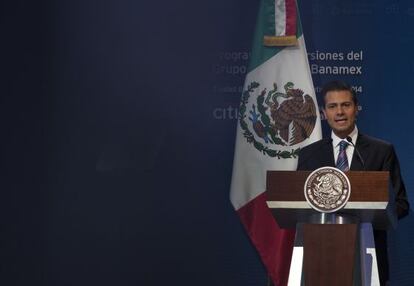Mexican economy will take off in 2015, predicts government
Many experts view Peña Nieto administration’s forecast of 3.7% GDP growth as conservative


The Mexican economy will take off again in 2015, says the Institutional Revolutionary Party (PRI) government of President Enrique Peña Nieto – and noted experts agree.
Following a period of anemic performance and constant downward revisions, GDP is expected to grow 3.7 percent next year. The forecast more than triples the result for 2013 (1.1 percent) and is over a point higher that the likely growth figure for 2014.
Above all, it breaks through the barrier that has kept growth in Latin America’s second-largest economy at an average 2.4 percent since 1981.
Still, the expected results are far from the five percent set by Peña Nieto as his target during his term in office.
The anticipated recovery is largely due to an economic boom in the United States, which buys 80 percent of Mexico’s exports.
The other major factor, say experts, is increased public spending, particularly in infrastructure, which will get $590 billion over the next four years (63 percent of it public money). The star project of the program is the new international airport that Norman Foster is building outside Mexico City in partnership with Fernando Romero, a Mexican architect who is the son-in-law of business mogul Carlos Slim.
The moderate nature of the forecast is partly due to midterm elections coming up next year
“This is a project that will make us grow in a context of stability and social inclusion,” said Treasury Secretary Luis Videgaray.
Unlike the two previous years, when government forecasts turned out to be too optimistic, the current GDP growth scenario for 2015 is described by specialists as low-key and even pessimistic.
The deliberate moderation is partly due to midterm elections coming up next year that will put voters’ feelings about Peña Nieto’s ambitious reforms and public works plan to the test.
“In 2015, growth will not only not be below 3.7 percent, but very possibly above it, enabling the government to adjust its figures upwards, which is a very beneficial thing during an election year,” notes Antonio de la Cuesta, director for political analysis at Centro de Investigaciones para el Desarrollo (Cidac), an independent think tank.
Raúl Feliz, a researcher at elite academic center CIDE, believes that the government’s growth forecast for next year is realistic based on available figures. “Anything above 3.7 percent is speculation,” he says.
The expansive effects of the legislative package passed by lawmakers in the last two years are still not fully reflected in the national budget. The energy reform, which the government trusts will attract massive amounts of capital and raise GDP by one point, will take years to materialize.
The expected recovery is largely because of an economic boom in the United States
Only tax reform has been immediately felt: higher levies on 40 percent of the tax-paying workforce have lowered the president’s popularity to one of its lowest levels.
The administration’s reply has been to pledge not to introduce new taxes during what is left of Peña Nieto’s term in office. But the new taxation system has already meant a 10-percent rise in tax receipts. This fresh influx of money, together with higher public debt – estimated at 3.5 percent of GDP for next year – means that the executive has a lot more leeway.
“They have unprecedented resources,” says De la Cuesta. “Now they have to decide whether to inject them into mid- and long-term projects that will encourage development, or whether to spend them on keeping the clientelism machine well-oiled in an election year and fattening up a bureaucracy that keeps growing due to all the new agencies being created as a result of the reforms.”
“I am not worried about the deficit, but about this increase in public spending not having the desired results in 2014,” says Gerardo Esquivel, who teaches economics at Colegio de México. “The impact has been low, and that speaks to the low quality of the spending.”
Tu suscripción se está usando en otro dispositivo
¿Quieres añadir otro usuario a tu suscripción?
Si continúas leyendo en este dispositivo, no se podrá leer en el otro.
FlechaTu suscripción se está usando en otro dispositivo y solo puedes acceder a EL PAÍS desde un dispositivo a la vez.
Si quieres compartir tu cuenta, cambia tu suscripción a la modalidad Premium, así podrás añadir otro usuario. Cada uno accederá con su propia cuenta de email, lo que os permitirá personalizar vuestra experiencia en EL PAÍS.
En el caso de no saber quién está usando tu cuenta, te recomendamos cambiar tu contraseña aquí.
Si decides continuar compartiendo tu cuenta, este mensaje se mostrará en tu dispositivo y en el de la otra persona que está usando tu cuenta de forma indefinida, afectando a tu experiencia de lectura. Puedes consultar aquí los términos y condiciones de la suscripción digital.








































